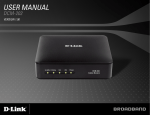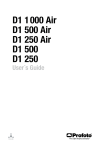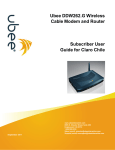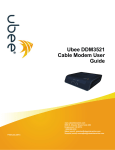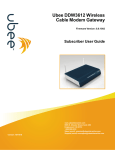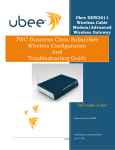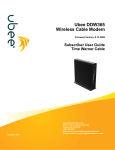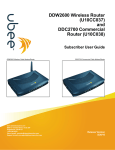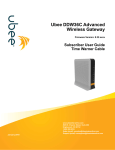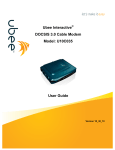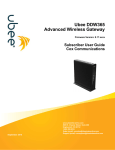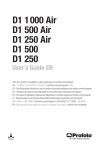Download Ubee DVW2110 User guide
Transcript
DVW2110 Wireless Voice Cable Modem and Router Subscriber User Guide for Telmex Colombia December 2011 www.ubeeinteractive.com 8085 S. Chester Street, Suite 200 Englewood, CO 80112 1.888.390.8233 Sales (email): [email protected] Support (email) [email protected] Notices and Copyrights Copyright © 2011 Ubee. All Rights Reserved. This document contains proprietary information of Ubee and is not to be disclosed or used except in accordance with applicable agreements. This material is protected by the copyright laws of the United States and other countries. It may not be reproduced, distributed, or altered in any fashion by any entity (either internal or external to Ubee), except in accordance with applicable agreements, contracts, or licensing, without the express written consent of Ubee and the business management owner of the material. Contents 1 Introduction . . . . . . . . . . . . . . . . . . . . . . . . . . . . . . . . . . . . . . . . . . . . . . . . . . . . . . . 1 1.1 1.2 1.3 1.4 1.5 1.6 1.7 1.8 1.9 Understanding Safety and Regulatory Information . . . . . . . . . . . . . . . . . . . . . . . . . . Safety . . . . . . . . . . . . . . . . . . . . . . . . . . . . . . . . . . . . . . . . . . . . . . . . . . . . . . . . . . . . . Understanding the Customer Premises Network . . . . . . . . . . . . . . . . . . . . . . . . . . . . Contacting Support . . . . . . . . . . . . . . . . . . . . . . . . . . . . . . . . . . . . . . . . . . . . . . . . . . Understanding Specifications, Standards, and Firmware . . . . . . . . . . . . . . . . . . . . . Understanding Default Values and Device Logins. . . . . . . . . . . . . . . . . . . . . . . . . . . Verifying Device Package Components. . . . . . . . . . . . . . . . . . . . . . . . . . . . . . . . . . . Understanding the DVW2110 Back Panel . . . . . . . . . . . . . . . . . . . . . . . . . . . . . . . . . Understanding the DVW2110 Front Panel and LED Behavior. . . . . . . . . . . . . . . . . . 1 1 3 3 3 5 6 7 8 2 Installing and Connecting the Device . . . . . . . . . . . . . . . . . . . . . . . . . . . . . . . . . . 9 2.1 2.2 2.3 Installing the DVW2110 . . . . . . . . . . . . . . . . . . . . . . . . . . . . . . . . . . . . . . . . . . . . . . . 9 Connecting a Device to Your Network . . . . . . . . . . . . . . . . . . . . . . . . . . . . . . . . . . . 10 Troubleshooting the Installation . . . . . . . . . . . . . . . . . . . . . . . . . . . . . . . . . . . . . . . . 13 3 Accessing the Web User Interface . . . . . . . . . . . . . . . . . . . . . . . . . . . . . . . . . . . . 15 3.1 Accessing the Web Interface as a User . . . . . . . . . . . . . . . . . . . . . . . . . . . . . . . . . . 15 4 Understanding the Cable Modem Menu . . . . . . . . . . . . . . . . . . . . . . . . . . . . . . . 17 4.1 4.2 4.3 4.4 4.5 4.6 Using the Cable Modem Information Option . . . . . . . . . . . . . . . . . . . . . . . . . . . . . . Using the Cable Modem Status Option . . . . . . . . . . . . . . . . . . . . . . . . . . . . . . . . . . Using the Cable Modem Downstream Option . . . . . . . . . . . . . . . . . . . . . . . . . . . . . Using the Cable Modem Upstream Option . . . . . . . . . . . . . . . . . . . . . . . . . . . . . . . Using the Modem Upstream Burst Option . . . . . . . . . . . . . . . . . . . . . . . . . . . . . . . . Using the Cable Modem Event Log Option . . . . . . . . . . . . . . . . . . . . . . . . . . . . . . . 17 19 20 21 22 23 5 Glossary . . . . . . . . . . . . . . . . . . . . . . . . . . . . . . . . . . . . . . . . . . . . . . . . . . . . . . . . . 25 Ubee DVW2110 Wireless Voice Cable Modem and Router Subscriber User Guide • December 2011 iii Ubee Interactive iv Ubee DVW2110 Wireless Voice Cable Modem and Router Subscriber User Guide • December 2011 1 Introduction Welcome to the Ubee family of data networking products. This document provides instructions for anyone who installs, configures, maintains, and uses the DVW2110 Wireless Voice Cable Modem and Router. Ubee recommends that you review this guide before installing and using the device. Topics See the following topics: 1.1 Understanding Safety and Regulatory Information on page 1 Safety on page 1 Understanding the Customer Premises Network on page 3 Contacting Support on page 3 Understanding Specifications, Standards, and Firmware on page 3 Understanding Default Values and Device Logins on page 5 Verifying Device Package Components on page 6 Understanding the DVW2110 Back Panel on page 7 Understanding the DVW2110 Front Panel and LED Behavior on page 8 Understanding Safety and Regulatory Information The following information provides safety and regulatory standards for anyone installing, maintaining, and using the DVW2110. 1.2 Safety WARNING: The following information provides safety guidelines for anyone installing and maintaining the DVW2110. Read all safety instructions in this guide before attempting to unpack, install, operate, or connect power to this product. Follow all instruction labels on the device itself. Comply with the following safety guidelines for proper operation of the device: Ubee DVW2110 Wireless Voice Cable Modem and Router Subscriber User Guide • December 2011 1 Introduction Ubee Interactive Always follow basic safety precautions to reduce the risk of fire, electrical shock and injury. To prevent fire or shock hazard, do not expose the unit to rain, moisture, or install this product near water. Never spill any form of liquid on or into this product. Do not use liquid cleaners or aerosol cleaners on or close to the product. Use a soft dry cloth for cleaning. Do not insert any sharp object into the product’s module openings or empty slots. Doing so may accidentally damage its parts and/or cause electric shock. Electrostatic discharge (ESD) can permanently damage semiconductor devices. Always follow ESD-prevention guidelines for equipment handling and storage. Use only the power adapter supplied with the device. Do not attach the power supply cable to building surfaces or floors. Do not place heavy objects on top of the device. Rest the power cable freely without any obstacles or heavy items set on top of it. Refrain from abusing, stepping or walking on the cable. Do not place the device on an unstable stand or table; the device may drop and become damaged. To protect the equipment from overheating, do not block the slots and openings in the module housing that provides ventilation. Do not expose this device to direct sunlight. Do not place any hot devices close to this device, as it may degrade or cause damage to it. 1.2.1 Eco-Environmental Statements The following eco-environmental statements apply to the DVW2110. Packaging Collection and Recovery Requirements: Countries, states, localities, or other jurisdictions may require that systems be established for the return and/or collection of packaging waste from the consumer, or other end user, or from sewer and waste water. Additionally, reuse, recovery, and/or recycling targets for the return and/or collection of the packaging waste may be established. For more information regarding collection and recovery of packaging and packaging waste within specific jurisdictions, contact Ubee Interactive at www.ubeeinteractive.com. 1.2.2 Regulatory Statements The following regulatory statements applies to the DVW2110. Industry North America Statement: This device complies with RSS-210 of the Industry North America Rules. Operation is subject to the following two conditions: (1) This device may not cause harmful interference, and (2) this device must accept any interference received, including interference that may cause undesired operation. 2 Ubee DVW2110 Wireless Voice Cable Modem and Router Subscriber User Guide • December 2011 Ubee Interactive Introduction Radiation Exposure Statement: This equipment complies with IC radiation exposure limits set forth for an uncontrolled environment. This equipment should be installed and operated with minimum distance 20cm between the radiator & your body. This device has been designed to operate with an antenna having a maximum gain of 2 dBi. Antenna having a higher gain is strictly prohibited per regulations of Industry North America. The required antenna impedance is 50 ohms. 1.3 Understanding the Customer Premises Network The following diagram illustrates the general connection network and uses of the DVW2110. Customer Premises Network Laptops/Other Wireless Devices ... WiFi Telephone Ubee DVW2110 WiFi Clients 1 Analog Telephone RJ11 Cable RF/Coax 1 Ethernet Enabled Device, PC, Gaming Console, etc. ... LAN RJ45 Or: Subscriber Network Extensions Ubee or off-the-shelf products can be added to expand subscriber network (for example, router, hub). 1.4 Contacting Support Subscribers must contact their service provider for direct support. Device documentation support may be available at: http://www.ubeeinteractive.com 1.5 Understanding Specifications, Standards, and Firmware Following are the features and specifications of the DVW2110: Interfaces and Standards Cable: F-Connector, Female Telephone: 1 - RJ11 Port LAN: 1 - 10/100Mbps RJ45 Port Antenna - 1 detachable DOCSIS 2.0/1.1/1.0 Compliant, Packet Cable 1.5/1.0 Compliant FCC/UL Certified, ENERGY STAR®-compliant power supply Ubee DVW2110 Wireless Voice Cable Modem and Router Subscriber User Guide • December 2011 3 Introduction Ubee Interactive Downstream* Frequency Range: 88MHz ~ 860 MHz Modulation: 64/256 QAM, Channel Bandwidth: 6 MHz Maximum Data Rate: 30Mbps (64QAM), 42.8Mbps (256QAM) RF Input/Output Power: -15 to +15 dBmV Input Impedance: 75 Ω Symbol Rate: 5.057/5.361/M symbols/sec *Actual speeds vary based on factors including network configuration, service tier, and network conditions. Upstream* Frequency Range: 5 MHz ~ 42 MHz Modulation A-TDMA: QPSK, 8, 16, 32, 64QAM, S-CMDA: QPSK, 8, 16, 32, 64, 128QAM, TDMA: QPSK, 16QAM Maximum Data Rate: 0.32 ~ 10.24Mbps (QPSK: 4QAM), 0.64 ~ 20.48Mbps (16QAM), 0.96 ~ 30.72Mbps (64QAM) RF Output Power: TDMA/ATDMA: +8dBmV to +54dBmV (32/64 QAM), ATDMA Only: +8dBmV to +55dBmV (8/16 QAM), +8dBmV to +58dBmV (QPSK), S-CDMA: +8dBmV to +53dBmV (all modulations) Symbol Rate: 160, 320, 640, 1280, 2560, 5120 Ksps *Actual speeds vary based on factors including network configuration, service tier, and network conditions. Voice Line Voltage On-Hook: -48 Volts, Loop Current: 25-40mA Ring Capability: 5REN, Hook State Signaling: Loop Start Supported Codecs: G.711-ulaw, G.711-alaw, G.723.1, BV16, ILBC, G.726-16, G.726-24, G.726-32, G.726-40, G.728, G.729, G.729E, G.729A, G.729B, TELEVENT, T.38. Additional customization available on request. RTP/RTCP for Voice Stream Control Dual Mac Built-In and Dual DHCP IP Dynamic QoS for Voice Stream IP Precedence and Signaling Protocol CLASS Call and Voice Mail Features Support Echo Cancellation (G.165, G.168) DTMF Pulse Detection and Generation (RFC 2833) Supported RFCs: 3435; 3261; 3262 Reverse Polarity to calculate call charges T.38 Fax protocol Security, Wireless, and Network VPN pass-through and VPN end-point (IPSec/L2TP/PPTP) 4 Ubee DVW2110 Wireless Voice Cable Modem and Router Subscriber User Guide • December 2011 Ubee Interactive Introduction NAT Firewall, MAC/IP/Port Filtering, Parental Control, Stateful Packet Inspection (SPI), DoS Attack Protection, WPS/ WPA/ WPA2/ WPA-PSK & 64/128-bit WEP Encryption Maximum of 4 SSIDs 802.11b/g/n Compliant with Wireless Link Speeds up to 65 Mbps* Wi-Fi Single Band (2.4GHz) DHCP Client/Server & Static IP Network Assignment, RIPv1/ v2, Ethernet 10/100/BaseT, Full-Duplex Auto-Negotiate Functionality, IPv4 and IPv6 TACAS and RADIUS Authentication Device Management WMM Power Save Technology (UAPSD) for Efficient Power Management of Wireless Devices Supports Local or Remote Management via Telnet, HTTP, SNMP, VSIF, and SSH Physical and Environmental Dimensions: 7.75in(w) x 5.4in(h) x 1.4in(d) Power Consumption: Maximum 8W ENERGY STAR® Compliant Power Supply: 12V @ 1.0A, Input Power: 100120VAC, 50-60Hz Operating Temperature: 0°C ~ 40°C (32° F to 104° F) Humidity: 5~95% (noncondensing) 1.6 Understanding Default Values and Device Logins This device is pre-configured with the following parameters: Local Port Address: 192.168.0.1 Web Interface Address: http://192.168.0.1 Operation Mode: Gateway Mode Subnet Mask: 255.255.255.0 1.6.1 Using Default User Names and Passwords The following user names and passwords are available at Cablemas: Subscriber Subscribers access the Web interface by opening a Web browser and going to the Web interface address http://192.168.0.1. The default user name and password is: User name: user Password: user Ubee DVW2110 Wireless Voice Cable Modem and Router Subscriber User Guide • December 2011 5 Introduction 1.6.2 Ubee Interactive Finding the MAC Address of the Device Use one of the following options to find the MAC address of the device: Option 1: Look on the bottom of the device for the Cable RF MAC Address. Option 2: Access the device Web interface and find the MAC address in the opening screen, (the Cable Modem Information screen). To access the Web interface, refer to Accessing the Web User Interface on page 15. 1.7 Verifying Device Package Components The package for the DVW2110 contains the following items: Item Description 1 - RJ45 Cable (Ethernet) Length ~ 6.0 ft RoHS & UL compliant Sample image, actual appearance subject to change. 1 - RJ11 Cable (Telephone) Sample image, actual appearance subject to change. 1 - AC Adapter Power Supply: 12V @ 1.0A Input Power: 100-120VAC, 50-60Hz Sample image, actual appearance subject to change. 6 Ubee DVW2110 Wireless Voice Cable Modem and Router Subscriber User Guide • December 2011 Ubee Interactive 1.8 Introduction Understanding the DVW2110 Back Panel The image below and the following table describe the device’s back panel connections. Label POWER Description Connects the device’s power adapter to the device. WARNING: Use only the power adapter shipped with this device. Failure to do so may cause damage to the device. TEL Connects an analog telephone using a standard RJ11 cable. Telephone service must be enabled through the service provider to use home telephony. ETHERNET Connects an Ethernet device such as a computer, gaming console, or a router/hub to the Internet using a standard RJ45 Ethernet cable. See the Understanding the Customer Premises Network on page 3 for more information. RESET Button disabled. An administrator can reset the device to factory defaults through the Web user interface or the management information base (MIB). CABLE Connects the device to the cable wall outlet or a cable splitter connected to the wall outlet. WPS Connects a PIN-protected Wi-Fi device to the cable modem when the Wi-Fi Protected Setup method is used. When the WPS button is pushed or triggered through the device’s Web UI, an LED on the top-front of the device flashes for four minutes until a PIN is entered from the wireless client, such as a laptop computer, that wants to connect. After a Wi-Fi client attaches successfully, the LED remains on for five minutes, and then turns off. Refer to Understanding the Wireless Menu on page 51 for more information. Ubee DVW2110 Wireless Voice Cable Modem and Router Subscriber User Guide • December 2011 7 Introduction 1.9 Ubee Interactive Understanding the DVW2110 Front Panel and LED Behavior The following image and table describe LED behavior of the DVW2110. The LED labels represent the following: ETHNET - Ethernet connection status. WPS - Wi-Fi Protected Setup status. WLAN - Wireless Local Area Network status. TEL - Telephone line status. READY - Ready to connect to the Internet. US - Upstream signal activity. DS - Downstream signal activity. POWER - Power is on (lit) or off (unlit). LED Label POWER DS US READY TEL ON ON ON ON BLINKS ON ON ON ON BLINKS ON ON ON ON BLINKS ON ON ON ON ON WLAN WPS ETHNET ON ON = Wireless device connected ON = Ethernet device connected OFF = Wireless device not connected BLINKS = WPS scan start OFF = Ethernet device not connected BLINKS= Ethernet activity OFF OFF Process Steps eMTA Initialization MTA DHCP MTA SNMP/TFTP RSIP On-hook eMTA normal operation AC power normal (AC power on) Off-hook AC power failure (AC power off) Firmware upgrade in progress 8 On-hook BLINKS OFF OFF OFF OFF Off-hook OFF OFF OFF ON BLINKS BLINKS ON Ubee DVW2110 Wireless Voice Cable Modem and Router Subscriber User Guide • December 2011 2 Installing and Connecting the Device Use these instructions to install and connect the DVW2110. Topics See the following topics: Installing the DVW2110 on page 9 Connecting a Device to Your Network on page 10 Troubleshooting the Installation on page 13 2.1 Installing the DVW2110 You install the device by connecting it to a power supply, your computer, internet service, and optional phone service. Subscribers must contact the internet service provider (ISP) to enable internet access, wireless networking, and telephony (voice). Installing voice service requires additional steps for the service provider, including cancelling the previous telephone provider service, porting the telephone number, and other tasks to minimize downtime during the transition. Typically, the service provider configures and connects the device, however, installation steps are provided here for your review. If you wish to confirm the setup, or add devices to your network, refer to Connecting a Device to Your Network on page 10. Steps To install the DVW2110: 1. Verify service has been activated on the provisioning system before installing at the customer premises. Contact the cable service providerfor instructions if service activation is not completed. 2. Remove the contents from the device packaging. Place the DVW2110 in an optimal location for connection to other devices, such as PCs or gaming consoles. Keep the wireless cable modem and wireless clients in open areas or far away from transformers, heavy-duty motors, microwave ovens, refrigerators, fluorescent lights, and other manufacturing equipment. These items can impact wireless signals. A wireless signal may become weaker after it has passed through metal, concrete, brick, walls, or floors. Place the device in a location that has an operating temperature of 0˚C to 40˚C (32˚F to 104˚F). Refer to Understanding Safety and Regulatory Information on page 1 for more safety regulations. 3. Power on your PC. The PC must have an Ethernet network adapter/Ethernet port and Ubee DVW2110 Wireless Voice Cable Modem and Router Subscriber User Guide • December 2011 9 Installing and Connecting the Device Ubee Interactive an internet browser installed, such as Netscape or Internet Explorer. The following browsers are supported: For Windows 2000, XP, Vista, Windows 7: Firefox 1.07 and higher, Internet Explorer v7 and above, Netscape. For MAC OS X, 10.2, and higher: Firefox 1.07 and higher, Safari 1.x and higher. 4. Using the power supply included in the product package, connect the power cord to the POWER outlet on the back of the modem and connect the other end into the power outlet. Warning: Use only the power adaptor shipped with this device. Failure to do so may cause damage the device. 5. Using the Ethernet cable included in the product package, connect one end of the Ethernet cable to your computer’s Ethernet port, and connect other end to the ETHERNET port on the cable modem. 6. Connect the coaxial cable from the cable wall outlet or a cable splitter connected to the cable wall outlet to the CABLE port on the device. 7. Connect one end of an RJ11 phone cable provided in the product package to one of the TEL ports on the device (a port that has been provisioned for voice service as specified by the service provider). Connect the other end to the phone port of the telephone. Note If voice service is not provisioned through the service provider, telephone service is not available. 2.2 Connecting a Device to Your Network Use one or more of the following sections to connect network devices and validate device functionality. Connecting an Ethernet Device on page 10 Connecting a Wireless Device on page 11 Connecting a Telephone on page 12 Troubleshooting the Installation on page 13 2.2.1 Connecting an Ethernet Device You can connect a device to your network, such as a computer, using an Ethernet cable. 10 Ubee DVW2110 Wireless Voice Cable Modem and Router Subscriber User Guide • December 2011 Ubee Interactive Installing and Connecting the Device Steps To connect an Ethernet device to the network: 1. Verify an Ethernet device (for example, a PC) is connected to the cable modem. See Installing and Connecting the Device on page 9. 2. Use the device LEDs to confirm operations. The POWER, DS, US, and READY LEDs are solidly lit in normal operations. The ETHNET LED is lit when a device is connected to the Ethernet port. Refer to Understanding Safety and Regulatory Information on page 1 for more information. 3. Open a Web browser and go to any Web site to validate network connectivity (for example, http://www.wikipedia.org). 4. If the connected device is a gaming console, perform an Internet connection test provided by your console. For more information, please contact your console manufacturer. 5. Refer to Troubleshooting the Installation on page 13 for troubleshooting information, if needed. 2.2.2 Connecting a Wireless Device Use these steps to connect a wireless device to the network (for example, a laptop computer). Use the device LEDs to confirm operations: The POWER, DS, US, and READY LEDs are solidly lit in normal operations. The WLAN LED must be solidly lit for wireless connections. Refer to Understanding the DVW2110 Front Panel and LED Behavior on page 8 for more information. Steps To connect a wireless device: 1. Access the wireless networking feature on your wireless device. On a Windows computer, for example, double-click the Wireless Networking icon in the system tray (lower-right side of the Windows desktop). Note If the icon is not present or you are using a different operating system, refer to the documentation for your computer to access wireless networking options. 2. the documentation for your computer to access wireless networking options. 3. Click View Wireless Networks. The screen displays a list of available SSIDs. The DVW2110 broadcasts the SSID as the name of the wireless network so that wireless clients can connect to it. 4. Double-click your SSID in the wireless networks window. The DVW2110 is shipped with a default SSID, which can be changed by the service provider if the subscriber Ubee DVW2110 Wireless Voice Cable Modem and Router Subscriber User Guide • December 2011 11 Installing and Connecting the Device Ubee Interactive requests. The default SSID is equal to the last 4 characters of the Cable RF MAC address printed on the bottom of the cable modem. For example: MAC Address = 906EBB360957 SSID = 0957 Note If you cannot see or connect to the SSID, contact the cable service provider to enable wireless services. 5. Enter the network key (WEP). This value is found in the Wireless Primary Network option. To find the default network key: a. Log in to the device using the MSO login. See Understanding Default Values and Device Logins on page 5. Note: If you do not have access to the MSO log in, contact your NOC or headend for further instructions. b. Click Wireless, and then click the Primary Network option. c. Select an encryption method. 6. Confirm connectivity by opening a Web browser and going to any Web site (for example, http://www.wikipedia.org). 7. Refer to Troubleshooting the Installation on page 13 for troubleshooting information. 2.2.3 Connecting a Telephone Voice service requires additional steps for the service provider, including cancelling the previous telephone provider service, porting the telephone number, and other tasks to minimize downtime during the transition. Note If voice service has not been provisioned through the service provider, telephone service is not available. Steps To connect a telephone: 1. Contact the cable service provider to have voice service enabled. 2. Connect an analog telephone to the TEL 1 or TEL 2 jack on the back panel of device. An RJ11 cable is supplied in product packaging. 3. Pick up the telephone receiver and listen for dial tone. Make a phone call or have someone call you. 12 Ubee DVW2110 Wireless Voice Cable Modem and Router Subscriber User Guide • December 2011 Ubee Interactive 2.3 Installing and Connecting the Device Troubleshooting the Installation Use the following tips for troubleshooting the installation. None of the LEDs are on when I power on the Wireless LAN Cable Modem. Verify the power outlet is energized and the power adaptor is connected to the power outlet. Check the connection between the power adapter and the cable modem. Power off cable modem by removing the power cord from the back of the unit. Wait for 5 seconds and power on the modem again. If the problem still exists, there may be a hardware problem. The Ethernet LED on the cable modem is not lit. Verify both ends of the Ethernet cable are properly connected. Restart the computer to re-establish a connection with the cable modem. Check for a resource conflict (Windows users only). 1. Right-click My Computer on your desktop and choose Properties. 2. Click the Hardware tab, and then choose Device Manager. 3. Look for a yellow exclamation point or red X over the NIC in the Network Adapters field. If you see either one, you may have an IRQ conflict. 4. Refer to the manufacturers documentation or contact the cable service provider for further assistance. Verify TCP/IP is the default protocol for your network interface card (NIC). Power cycle the cable modem by removing the power adapter from the electrical outlet and plugging it back in. Wait until the cable modem re-establishes communications with the cable service provider. General Connectivity Issues: If your PC is connected to a hub or gateway, connect the PC directly into an Ethernet port on the cable modem. If you are using a cable splitter, remove the splitter and connect the cable modem directly to the cable wall outlet. Wait several minutes for the cable modem to reestablish communications with the cable service provider. The Ethernet cable may be damaged. Try another cable. If none of these suggestions work, contact the cable service provider for further assistance. Ubee DVW2110 Wireless Voice Cable Modem and Router Subscriber User Guide • December 2011 13 Installing and Connecting the Device 14 Ubee Interactive Ubee DVW2110 Wireless Voice Cable Modem and Router Subscriber User Guide • December 2011 3 Accessing the Web User Interface The Web interface allows you to install, view modem settings, and monitor the DVW2110 Wireless Voice Cable Modem and Router. This chapter explains how to access the Web interface. Users are able to access different options based on their login. Topics See the following topics: Accessing the Web Interface as a User on page 15 Understanding Operation Modes and the Web User Interface on page 19 3.1 Accessing the Web Interface as a User Use the following procedure to access the Web interface as a basic user. Steps To log in to the Web interface user account: 1. Verify a PC is connected to the device as explained in Connecting a Device to Your Network on page 10. 2. From your PC, launch an Internet browser, for example, Internet Explorer. 3. In the Internet browser, enter the following address and press <Enter>. http://192.168.0.1 The Cable Modem main menu is displayed. Ubee DVW2110 Wireless Voice Cable Modem and Router Subscriber User Guide • December 2011 15 Accessing the Web User Interface 16 Ubee Interactive Ubee DVW2110 Wireless Voice Cable Modem and Router Subscriber User Guide • December 2011 4 Understanding the Cable Modem Menu The Modem menu provides access to information about the modem, such as downstream and upstream connections and event logs. Topics See the following topics: Using Using Using Using Using Using the the the the the the Cable Modem Information Option on page 17 Cable Modem Status Option on page 19 Cable Modem Downstream Option on page 20 Cable Modem Upstream Option on page 21 Modem Upstream Burst Option on page 22 Cable Modem Event Log Option on page 23 Steps To access the Modem menu: 1. Access the Web interface. Refer to Accessing the Web User Interface on page 15. 2. Click the Modem link from the top menu. The Cable Modem menu is displayed. 4.1 Using the Cable Modem Information Option The Cable Modem Information screen is a read-only screen that displays the device’s basic software and hardware configuration. Ubee DVW2110 Wireless Voice Cable Modem and Router Subscriber User Guide • December 2011 17 Understanding the Cable Modem Menu Ubee Interactive Steps To view modem information: 1. Access the Web interface. 2. Click the Modem link from the top menu. 3. Click the Information link from the left side of the screen. Field explanations are listed following the screen example. Label Description Cable Modem Information 18 Cable Modem Displays the current DOCSIS standard of the device. MAC Address Displays the unique Media Access Control (MAC) hardware address of cable modem RF interface. Serial Number Displays the unique manufacturer serial number of the device. Boot Code Version Displays the boot software code version of the device. Software Version Displays the general software version of the device. Hardware Version Displays the internal version number that identifies the hardware design. CA Key Displays the device Certificate Authority (CA) key that is transferred from the service provider’s server after the cable modem is authenticated. The key is used to secure communication between the service provider and the cable modem. Ubee DVW2110 Wireless Voice Cable Modem and Router Subscriber User Guide • December 2011 Ubee Interactive Understanding the Cable Modem Menu Label Description MTA Information 4.2 MAC Address DIsplays the MAC address of the MTA. The MTA module (voice/telephony) of the device has a unique MAC address, like the cable modem module. CA Key Displays the MTA module (voice/telephony) Certificate Authority (CA) key that is transferred from the service provider after the cable modem is authenticated. Using the Cable Modem Status Option The Status screen of the Web interface is a read-only screen that displays the device’s general connection information. Steps To view modem status: 1. Access the Web interface. 2. Click the Modem link from the top menu. 3. Click the Status link from the left side of the screen. Field explanations are listed following the screen example. Label Description Acquired Downstream Channel Displays a Downstream channel that the cable modem is trying to lock to and the progress. Ranged Upstream Channel Displays an Upstream channel that the cable modem is trying to lock to and the progress. CM Provisioning State Indicates the state of the device, Operational or otherwise (for example, Disabled). MTA Provisioning State Indicates the state of the voice portion (MTA) of the device, Operational or otherwise (for example, N/A). Ubee DVW2110 Wireless Voice Cable Modem and Router Subscriber User Guide • December 2011 19 Understanding the Cable Modem Menu 4.3 Ubee Interactive Using the Cable Modem Downstream Option The Downstream screen displays detailed information on the device’s connection to downstream channels from the service provider. Steps To view downstream information: 1. Access the Web interface. 2. Click the Modem link from the top menu. 3. Click the Downstream link from the left side of the screen. Field explanations are listed following the screen example. Label Frequency Displays the downstream channel frequency on which the cable modem is scanning. Lock Status Displays if the cable modem succeeded in locking to a downstream channel. Channel ID Displays the downstream channel ID. Modulation Displays the modulation method that’s required for the downstream channel to lock on to by the cable modem. This method is determined by the service provider. Symbol Rate (Msym/sec) Displays the symbol rate. The current cable modem downstream symbol rates are: QAM64 is 5056941 sym/sec, QAM256 is 5360537 sym/sec. Interleave Depth Displays the current cable modem downstream Interleave depth (4/8/16/32/64/128/other). Power Level (dBmV) 20 Description Displays the receiver power level after ranging process. Ubee DVW2110 Wireless Voice Cable Modem and Router Subscriber User Guide • December 2011 Ubee Interactive Understanding the Cable Modem Menu Label 4.4 Description RxMER (dB) Displays the Receiver Modulation Error Ratio. The RxMER is used to quantify the performance of a digital radio receiver in a communications system using digital modulation. Correctable Codewords Displays the quantity of codewords which are correctable. Uncorrectable Codewords Displays the quantity of codewords which are not correctable. Refresh Recaptures and displays screen values. Using the Cable Modem Upstream Option The Upstream screen displays detailed information on the device’s connection to upstream channels to the service provider. Steps To view upstream information: 1. Access the Web interface. 2. Click the Modem link from the top menu. 3. Click the Upstream link from the left side of the screen. Field explanations are listed following the screen example. Label Description Channel Type Displays the channel type. Channel ID Displays the current cable modem upstream channel ID. Frequency (HZ) Displays the current cable modem upstream frequency in hertz. Ubee DVW2110 Wireless Voice Cable Modem and Router Subscriber User Guide • December 2011 21 Understanding the Cable Modem Menu Ubee Interactive Label 4.5 Description Lock Status Displays the upstream lock status. Modulation Displays the current cable modem upstream modulation type (QPSK/ QAM8 /QAM16/ QAM32/ QAM64/ QAM128/ QAM256). Symbol Rate (Ksym/sec) Displays the symbol rate in kilosymbols per second. Upstream Mini-Slot Size Displays the current cable modem upstream mini-slot size in Timebase Ticks of 6.25. Power Level (dBmV) Displays the current cable modem upstream transmit power. T-1 through T-4 Timeouts T-1-Displays DHCP time expiration, T-2-Displays DHCP time expiration, T-3-Displays RNG-RSP time expiration, T-4Displays RNG time expiration. Refresh Recaptures and displays screen values. Using the Modem Upstream Burst Option The Upstream Burst screen displays detailed information on the device’s upstream data flow to the service provider. Steps To view upstream burst information: 1. Access the Web interface. 2. Click the Modem link from the top menu. 3. Click the Upstream Burst link from the left side of the screen. Field explanations are listed following the screen example. Note Column headings in the Cable Modem Upstream Burst table indicate the Interval Usage Codes (IUCs) used to transmit the data. 22 Ubee DVW2110 Wireless Voice Cable Modem and Router Subscriber User Guide • December 2011 Ubee Interactive 4.6 Understanding the Cable Modem Menu Using the Cable Modem Event Log Option The Event Log screen displays log information that may be useful to diagnose operational issues with the device. It also displays all logins to this Web interface. Steps To view event log information: 1. Access the Web interface. 2. Click the Modem link from the top menu. 3. Click the Event Log link from the left side of the screen. Field explanations are listed following screen example. Ubee DVW2110 Wireless Voice Cable Modem and Router Subscriber User Guide • December 2011 23 Understanding the Cable Modem Menu Ubee Interactive Label 24 Description First Time Displays the time of the event. Last Time Displays the last time of the event. Priority Displays the event log severity. Description Displays a detailed description of the event log. Refresh/Clear Log Refreshes the event log record. Clear Log erases the screen. Ubee DVW2110 Wireless Voice Cable Modem and Router Subscriber User Guide • December 2011 5 Glossary This chapter defines terms used in this guide and in the industry. Broadcast A packet sent to all devices on a network. Cable Modem Termination System (CMTS) Typically located in the cable company’s headend, the CMTS is equipment that provides highspeed data services to subscribers, such as cable Internet and VoIP. Channel Bonding A computer networking configuration where two or more network interfaces are combined on a host computer for redundancy or increased throughput. Data is transmitted over these channels as if they are one channel. Customer Premises Equipment (CPE) Equipment such as telephones, routers, and modems located at a subscribers location to enable customers access to communication services. Default Gateway The routing device used to forward all traffic that is not addressed to a computer on the local subnet. Demilitarized Zone (DMZ) Allows one IP address (or computer) to be placed in between the firewall and the Internet (usually for gaming and video conferencing). This allows risky, open access to the Internet. Domain A subnetwork comprised of a group of clients and servers under the control of one security database. Domain Name A descriptive name for an address or group of addresses on the Internet. Domain names are in the form of a registered entity name plus one of a number of predefined top-level suffixes, such as .com, .edu, .org. Domain Name System (DNS) An Internet service that locates and translates domain names into IP addresses. Because domain names are alphabetic, they are easier to remember. However, the Internet is based on IP addresses. Every time you use a domain name, a DNS service translates the name into the corresponding IP address. The DNS system is actually its own network. If one DNS server does not know how to translate a particular domain name, it asks another one, and so on, until the correct IP address is returned. Downstream A term to describe the direction of data from the network service provider to the customer. Ubee DVW2110 Wireless Voice Cable Modem and Router Subscriber User Guide • December 2011 25 Glossary Ubee Interactive Dynamic Host Configuration Protocol (DHCP) A protocol that centrally automates the assignment of IP addresses (see IP Address) in a network. Using the Internet’s set of protocols (TCP/IP) (see Transmission Control Protocol/Internet Protocol (TCP/IP)) , each machine that can connect to the Internet needs a unique IP address. For example, when the service provider sets up computer users with a connection to the Internet, an IP address is assigned to each machine. DHCP lets the service provider distribute IP addresses and automatically sends a new IP address when a computer is plugged in to the high-speed Internet network. DHCP uses the concept of a “lease” or amount of time an IP address is valid for a computer. Lease times can vary. Ethernet A standard network protocol that specifies how data is placed on and retrieved from a common transmission medium. It forms the underlying transport vehicle used by several upper-level protocols, including TCP/IP and XNS (see Xerox Network Services (XNS)) . Firewall A highly effective method to block unsolicited traffic from outside the connected computers in your gateway. Gateway A local device, usually a router, that connects hosts on a local network to other networks – sometimes with different incompatible communication protocols. Headend A main facility to process and distribute Internet communication signals. Headend may also refer to cable television signals and power line communication facilities. Internet Protocol (IP) The method or protocol by which data is sent from one computer to another on the Internet. It is a standard set of rules, procedures, or conventions relating to the format and timing of data transmission between two computers that they must accept and use to understand each other. Used in conjunction with the Transfer Control Protocol (TCP) to form TCP/IP. IP Address In the most widely installed level of the IP today, an IP address is a 32-bit binary digit number that identifies each sender or receiver of information that is sent in packet form across the Internet. When you request a Web page or send an e-mail, the IP part of TCP/IP includes your IP address. IP sends your IP address to the IP address obtained by looking up the domain name in the URL (see Uniform Resource Locator (URL)) you requested or in the e-mail address to which you are sending a note. A dynamic IP address is an IP address that is automatically assigned to a client station in a TCP/IP network, typically by a DHCP server. Internet Service Provider (ISP) A company that provides individuals and companies access to the Internet and other related services. Interval Usage Code (IUC) Interval usage codes define different profiles for upstream burst profiles to use for the data. IUCs are sent to the cable modem from the CMTS to tell the device important characteristics to use for the burst, such as modulation type, preamble length, and so on. 26 Ubee DVW2110 Wireless Voice Cable Modem and Router Subscriber User Guide • December 2011 Ubee Interactive Glossary Local Area Network (LAN) A group of computers and associated devices such as printers and servers that share a common communication line and other resources within a small geographic area. Media Access Control (MAC) Address A unique number assigned by the manufacturer to any Ethernet networking device, such as a network adapter, that allows the network to identify it at the hardware level. Usually written in the form 01:23:45:67:89:ab. Megabits per Second (Mbps) A unit of measurement for data transmission that represents one million bits per second. Maximum Transmission Unit (MTU) The size in bytes of the largest packet that can be sent or received. Network Address Translation (NAT) A technique by which several hosts or computers share a single IP address for access to the Internet. NAT enables a LAN to use one set of IP addresses for internal traffic and a second set of addresses for external traffic, and provides a type of firewall by hiding internal IP addresses. Network Basic Input Output System (NetBIOS) An application programming interface (API) that augments the DOS BIOS by adding special functions for LANs. Almost all Windows-based LANs for PCs are based on the NetBIOS. Network Operations Center (NOC) A location that controls computer, television, or telecommunications networks. Large organizations usually have more than one network operations center to manage multiple networks. Packet A block of information sent over a network. A packet typically contains a source and destination network address, some protocol and length information, a block of data, and a checksum. Ranging A process in which a cable modem sends a range request at a power of 8 dBmV (very low power). If it does not rec i eve a range response from the CMTS, the cable modem re-transmits the range request at a 3 dB higher power level and continues the process until a range response is received. Routing Information Protocol (RIP) A protocol in which routers periodically exchange information with one another to determine minimum-distance paths between sources and destinations. Router A device that forwards data between networks. An IP router forwards data based on IP source and destination addresses. Ubee DVW2110 Wireless Voice Cable Modem and Router Subscriber User Guide • December 2011 27 Glossary Ubee Interactive Subnet A portion of a network that shares a common address component. On TCP/IP networks, subnets are defined as all devices whose IP addresses have the same prefix. For example, all devices with IP addresses that start with 10.1.10 would be part of the same subnet. IP networks are divided using a subnet mask. Subnet Mask Combined with the IP address, the IP subnet mask allows a device to know which other addresses are local to it, and which must be reached through a gateway or router. A number that explains which part of an IP address comprises the network address and which part is the host address on that network. Telnet A network protocol used on the Internet or a local area network. Provides bi-directional interactive text-oriented communications using a virtual terminal connection. Terminal Access Controller Access-Control System (TACACS) A remote authentication protocol used to communicate with an authentication server to determine if the user is allowed to access the network. Time Division Multiple Access (TDMA) A method in which cable modems must time-share the upstream channel because there are many cable modems and only one upstream channel frequency. Transmission Control Protocol (TCP) A method (protocol) used with the IP to send data in the form of message units (datagrams) between network devices over a LAN or WAN. While IP handles the actual delivery of the data (routing), TCP keeps track of the individual units of data (packets) that a message is divided into for efficient delivery over the network. TCP requires the receiver of a packet to return an acknowledgment of receipt to the sender of the packet. Transmission Control Protocol/Internet Protocol (TCP/IP) The basic communication language or set of protocols to communicate over a network (developed specifically for the Internet). TCP/IP defines a suite or group of protocols. Trivial File Transfer Protocol A file transfer protocol used to transfer automatically configuration or boot files. Uniform Resource Identifier (URI) A string of characters used to identify a name or a resource on the Internet. Upstream A term to describe the direction of data from the customer to the network service provider. Uniform Resource Locator (URL) A URI that specifies where a known resource is available and how to retrieve it. 28 Ubee DVW2110 Wireless Voice Cable Modem and Router Subscriber User Guide • December 2011 Ubee Interactive Glossary Wide Area Network (WAN) A long-distance link or computer network that spans a relatively large geographical area that connects remotely located LANs. Typically, a WAN consists of two or more LANs. The Internet is a large WAN. Wi-Fi Protected Setup (WPS) A security protocol for wireless home networks. Created by the Wi-Fi Alliance, this protocol allows home users to easily set up wireless security and add new devices without needing to enter long passwords. Wireless Local Area Network (WLAN) A method that links two or more devices to provide a connection through an access point the wider Internet. Users can move within the local coverage area and stay connect to the network. Xerox Network Services (XNS) A protocol suite developed by Xerox that provides general purpose network communications, Internet routing, and packet delivery. Ubee DVW2110 Wireless Voice Cable Modem and Router Subscriber User Guide • December 2011 29 Glossary 30 Ubee Interactive Ubee DVW2110 Wireless Voice Cable Modem and Router Subscriber User Guide • December 2011


































